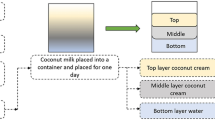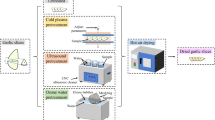Abstract
This study reports on the formation of stable emulsion of flaxseed oil (1 % v/v) in carrot juice (CJFO) using 20-kHz ultrasound (US) at 176 W and 4 min of processing time. The shear forces generated by acoustic cavitation are responsible for the production of emulsion droplets of size 0.6 μm. Pectin acted as an emulsifier providing stability by creating electrostatic repulsion (ζ potential −30 mV) between emulsion droplets and the emulsions were stable up to 8 days at 4 ± 2 °C. The viscosity of the emulsion remained unchanged with sonication time (up to 8 min) and upon storage. The unaffected flow behavior of emulsions was an advantage to adapt it to existing pipelines in food industries. Sonication led to an increase in carotenoid content to about 1.5 mg/100 ml of juice. In addition, an increase in lipid oxidation of emulsion was observed due to prooxidant characteristics of carotenoid. However, industrially, it can be prevented by adding antioxidants or by providing inert gas blanket to the process cell. In total, the formation of stable emulsions without addition of external emulsifiers and stabilizers, by using US process, is perceived a positive step towards new product/process development.





Similar content being viewed by others
References
Abdel-Moneim, A. E. (2012). Flaxseed oil as a neuroprotective agent on lead acetate-induced monoamineric alterations and neurotoxicity in rats. Biological Trace Element Research, 148(3), 363–370.
Abid, M., Jabbar, S., Wu, T., Hashim, M. M., Hu, B., Lei, S., & Zeng, X. (2014). Sonication enhances polyphenolic compounds, sugars, carotenoids and mineral elements of apple juice. Ultrasonics Sonochemistry, 21(1), 93–97.
Akhtar, M., Dickinson, E., Mazoyer, J., & Langendorff, V. (2002). Emulsion stabilizing properties of depolymerized pectin. Food Hydrocolloids, 16(3), 249–256.
Ashokkumar, M., & Mason, T. J. (2007). Sonochemistry Kirk-othmer encyclopedia of chemical technology (pp. 1–34). New York: John Wiley & Sons, Inc.
Ashokkumar, M., Sunartio, D., Kentish, S., Mawson, R., Simons, L., Vilkhu, K., & Versteeg, C. (2008). Modification of food ingredients by ultrasound to improve functionality: a preliminary study on a model system. Innovative Food Science & Emerging Technologies, 9(2), 155–160.
Butalla, A. C., Crane, T. E., Patil, B., Wertheim, B. C., Thompson, P., & Thomson, C. A. (2012). Effects of a carrot juice intervention on plasma carotenoids, oxidative stress, and inflammation in overweight breast cancer survivors. Nutrition and Cancer, 64(2), 331–341.
Canselier, J., Delmas, H., Wilhelm, A., & Abismail, B. (2002). Ultrasound emulsification—an overview. Journal of Dispersion Science and Technology, 23(1–3), 333–349.
Carcel, J. A., Garcia-Perez, J. V., Riera, E., & Mulet, A. (2011). Improvement of convective drying of carrot by applying power ultrasound—influence of mass load density. Drying Technology, 29(2), 174–182.
Chen, Y., D’Angelo, L., Shen, C., & King, G. A. (2009). US20090018186 A1. United States Patent Publication.
Chen, C., Zhao, W., Yang, R., & Zhang, S. (2012). Effects of pulsed electric field on colloidal properties and storage stability of carrot juice. International Journal of Food Science & Technology, 47(10), 2079–2085.
Dickinson, E. (2003). Hydrocolloids at interfaces and the influence on the properties of dispersed systems. Food Hydrocolloids, 17(1), 25–39.
Funami, T., Zhang, G., Hiroe, M., Noda, S., Nakauma, M., Asai, I., et al. (2007). Effects of the proteinaceous moiety on the emulsifying properties of sugar beet pectin. Food Hydrocolloids, 21(8), 1319–1329.
Gogate, P. R., Sutkar, V. S., & Pandit, A. B. (2011). Sonochemical reactors: important design and scale up considerations with a special emphasis on heterogeneous systems. Chemical Engineering Journal, 166(3), 1066–1082.
Heinonen, M., Haila, K., Lampi, A.-M., & Piironen, V. (1997). Inhibition of oxidation in 10 % oil-in-water emulsions by β-carotene with α- and γ-tocopherols. Journal of the American Oil Chemists’ Society, 74(9), 1047–1052.
Houben, K., Jolie, R. P., Fraeye, I., Van Loey, A. M., & Hendrickx, M. E. (2011). Comparative study of the cell wall composition of broccoli, carrot, and tomato: structural characterization of the extractable pectins and hemicelluloses. Carbohydrate Research, 346(9), 1105–1111.
Immerzeel, P., Eppink, M. M., De Vries, S. C., Schols, H. A., & Voragen, A. G. J. (2006). Carrot arabinogalactan proteins are interlinked with pectins. Physiologia Plantarum, 128(1), 18–28.
Jabbar, S., Abid, M., Wu, T., Muhammad Hashim, M., Hu, B., Lei, S., et al. (2014a). Study on combined effects of blanching and sonication on different quality parameters of carrot juice. International Journal of Food Sciences and Nutrition, 65(1), 28–33.
Jabbar, S., Abid, M., Hu, B., Wu, T., Hashim, M. M., Lei, S., et al. (2014b). Quality of carrot juice as influenced by blanching and sonication treatments. LWT - Food Science and Technology, 55(1), 16–21.
Jafari, S. M., He, Y. H., & Bhandari, B. (2006). Nano-emulsion production by sonication and microfluidization—a comparison. International Journal of Food Properties, 9(3), 475–485.
Jafari, S. M., He, Y. H., & Bhandari, B. (2007). Production of sub-micron emulsions by ultrasound and microfluidization techniques. Journal of Food Engineering, 82(4), 478–488.
Jiqu, X., Wei, Y., Qianchun, D., Qingde, H., Jin’e, Y., & Fenghong, H. (2012). Flaxseed oil and α-lipoic acid combination reduces atherosclerosis risk factors in rats fed a high-fat diet. Lipids in Health and Disease, 11(1), 48.
Kentish, S., & Ashokkumar, M. (2011). The physical and chemical effects of ultrasound. In H. Feng, G. Barbosa-Canovas, & J. Weiss (Eds.), Ultrasound technologies for food and bioprocessing (pp. 1–12). New York: Springer.
Kentish, S., Wooster, T. J., Ashokkumar, M., Balachandran, S., Mawson, R., & Simons, L. (2008). The use of ultrasonics for nanoemulsion preparation. Innovative Food Science & Emerging Technologies, 9(2), 170–175.
Kiokias, S., & Gordon, M. H. (2004). Antioxidant properties of carotenoids in vitro and in vivo. Food Reviews International, 20(2), 99–121.
Leong, T., Ashokkumar, M., & Kentish, S. (2011). The fundamentals of power ultrasound—a review. Acoustics Australia, 39(2), 54–63.
Leroux, J., Langendorff, V., Schick, G., Vaishnav, V., & Mazoyer, J. (2003). Emulsion stabilizing properties of pectin. Food Hydrocolloids, 17(4), 455–462.
Li, P. H., & Chiang, B. H. (2012). Process optimization and stability of D-limonene-in-water nanoemulsions prepared by ultrasonic emulsification using response surface methodology. Ultrasonics Sonochemistry, 19(1), 192–197.
Liutkevicius, A. (2007). Functional food development: impact of technological factors on the quality of whey beverages with flaxseed oil. Milchwissenschaft, 62(1), 73.
Maillard, V., Hoinard, C., Arab, K., Jourdan, M.-L., Bougnoux, P., & Chajès, V. (2006). Dietary [beta]-carotene inhibits mammary carcinogenesis in rats depending on dietary [alpha]-linolenic acid content. The British Journal of Nutrition, 96(1), 18–21.
Massiot, P., Rouau, X., & Thibault, J. F. (1988). Characterisation of the extractable pectins and hemicelluloses of the cell wall of carrot. Carbohydrate Research, 172(2), 229–242.
Mazoyer, J., Leroux, J., & Bruneau, G. (1999). US5900268 A. United states patent publication.
Noda, R., Sekine, S., Ogasawara, C., Takeuchi, H., Ikuina, J., & Toyoshima, T. (2011). 2011/0111112 A1. United States Patent Application Publication: L. Nisshin Oillio Group.
Palozza, P. (1998). Prooxidant actions of carotenoids in biologic systems. Nutrition Reviews, 56(9), 257–265.
Pinelo, M., Zeuner, B., & Meyer, A. S. (2010). Juice clarification by protease and pectinase treatments indicates new roles of pectin and protein in cherry juice turbidity. Food and Bioproducts Processing, 88(2–3), 259–265.
Piorkowski, D. T., & McClements, D. J. (2014). Beverage emulsions: recent developments in formulation, production, and applications. Food Hydrocolloids, 42(Part 1(0)), 5–41.
Potter, A. S., Foroudi, S., Stamatikos, A., Patil, B. S., & Deyhim, F. (2011). Drinking carrot juice increases total antioxidant status and decreases lipid peroxidation in adults. Nutrition Journal, 10(1), 96.
Ramisetty, K. A., Pandit, A. B., & Gogate, P. R. (2014). Novel approach of producing oil in water emulsion using hydrodynamic cavitation reactor. Industrial & Engineering Chemistry Research, 53(42), 16508–16515.
Ramisetty, K. A., Pandit, A. B., & Gogate, P. R. (2015). Ultrasound assisted preparation of emulsion of coconut oil in water: understanding the effect of operating parameters and comparison of reactor designs. Chemical Engineering and Processing: Process Intensification, 88, 70–77.
Romero, A., Beaumal, V., David-Briand, E., Cordobes, F., Guerrero, A., & Anton, M. (2011). Interfacial and oil/water emulsions characterization of potato protein isolates. Journal of Agricultural and Food Chemistry, 59(17), 9466–9474.
Salvia-Trujillo, L., Rojas-Graü, A., Soliva-Fortuny, R., & Martín-Belloso, O. (2013). Physicochemical characterization of lemongrass essential oil–alginate nanoemulsions: effect of ultrasound processing parameters. Food and Bioprocess Technology, 6(9), 2439–2446.
Shanmugam, A., & Ashokkumar, M. (2014a). Ultrasonic preparation of stable flax seed oil emulsions in dairy systems—physicochemical characterization. Food Hydrocolloids, 39, 151–162.
Shanmugam, A., & Ashokkumar, M. (2014b). Functional properties of ultrasonically generated flaxseed oil-dairy emulsions. Ultrasonics Sonochemistry, 21(5), 1649–1657.
Sharma, H. K., Kaur, J., Sarkar, B. C., Singh, C., & Singh, B. (2009). Effect of pretreatment conditions on physicochemical parameters of carrot juice. International Journal of Food Science & Technology, 44(1), 1–9.
Sharma, K. D., Karki, S., Thakur, N. S., & Attri, S. (2012). Chemical composition, functional properties and processing of carrot—a review. Journal of Food Science and Technology, 49(1), 22–32.
Siew, C. K., & Williams, P. A. (2008). Role of protein and ferulic acid in the emulsification properties of sugar beet pectin. Journal of Agricultural and Food Chemistry, 56(11), 4164–4171.
Sinchaipanit, P., & Kerr, W. L. (2007). Effect of reducing pulp-particles on the physical properties of carrot juice. ASEAN Food Journal, 14(3), 205–214.
Singh, K. K., Mridula, D., Rehal, J., & Barnwal, P. (2011). Flaxseed: a potential source of food, feed and fiber. Critical Reviews in Food Science and Nutrition, 51(3), 210–222.
Soria, A. C., Corzo-Martinez, M., Montilla, A., Riera, E., Gamboa-Santos, J., & Villamiel, M. (2010). Chemical and physicochemical quality parameters in carrots dehydrated by power ultrasound. Journal of Agricultural and Food Chemistry, 58(13), 7715–7722.
Szterk, A., Roszko, M., & Górnicka, E. (2013). Chemical stability of the lipid phase in concentrated beverage emulsions colored with natural [beta]-carotene. Journal of the American Oil Chemists’ Society, 90(4), 483–491.
Thakur, B. R., Singh, R. K., Handa, A. K., & Rao, M. A. (1997). Chemistry and uses of pectin—a review. Critical Reviews in Food Science and Nutrition, 37(1), 47–73.
Tian, C., Fan, C., Liu, X., Xu, F., & Qi, K. (2011). Brain histological changes in young mice submitted to diets with different ratios of n-6/n-3 polyunsaturated fatty acids during maternal pregnancy and lactation. Clinical Nutrition, 30(5), 659–667.
Xingfeng, G., Wenting, Z., Xueli, P., Xiaojun, L., Xiaosong, H., & Jihong, W. (2014). Emulsion stabilizing properties of pectins extracted by high hydrostatic pressure, high-speed shearing homogenization and traditional thermal methods: a comparative study. Food Hydrocolloids, 35, 217–225.
Zhou, L., Wang, Y., Hu, X., Wu, J., & Liao, X. (2009). Effect of high pressure carbon dioxide on the quality of carrot juice. Innovative Food Science & Emerging Technologies, 10(3), 321–327.
Acknowledgments
Akalya Shanmugam acknowledges financial support—Melbourne International Research Scholarship and Melbourne International Fee Remission Scholarship provided by University of Melbourne, Australia. Authors also thank Stoney Creek Oil Products Pty Ltd, Australia, for providing flaxseed oil as a gift sample for research.
Author information
Authors and Affiliations
Corresponding author
Electronic supplementary material
Below is the link to the electronic supplementary material.
ESM 1
(DOCX 392 kb)
Rights and permissions
About this article
Cite this article
Shanmugam, A., Ashokkumar, M. Characterization of Ultrasonically Prepared Flaxseed oil Enriched Beverage/Carrot Juice Emulsions and Process-Induced Changes to the Functional Properties of Carrot Juice. Food Bioprocess Technol 8, 1258–1266 (2015). https://doi.org/10.1007/s11947-015-1492-1
Received:
Accepted:
Published:
Issue Date:
DOI: https://doi.org/10.1007/s11947-015-1492-1




